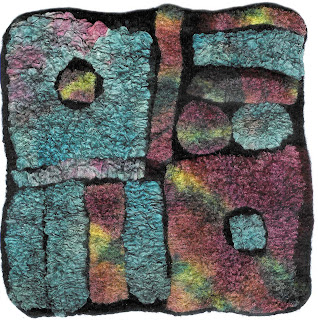In April, I traveled down to California to the Tin Thimble to take a class from my friend Leiko Uchiyama. I was finally able to get the time to download the photos from the workshop I took at this workshop. I took
the Pine Needle Samples workshop with her.
It was a terrific class and I really enjoyed seeing Leiko again. We figured it had been almost ten years
since we had seen each other!
Here are Leiko and I with one of her pieces at an exhibit she was featured in.
I was having difficulty with the technique at first because I made my "needles" too thick, but I persisted and eventually got the technique correct. I then tried other fibers (the teal one below left is a silk/wool blend) and putting the lace into a shape (The red background with a circle of orange lace in the middle below right.) I really felt good about these samples-like I accomplished something because I could get the lovely lace. Eventually, it is this technique I used in my project.
I was having difficulty with the technique at first because I made my "needles" too thick, but I persisted and eventually got the technique correct. I then tried other fibers (the teal one below left is a silk/wool blend) and putting the lace into a shape (The red background with a circle of orange lace in the middle below right.) I really felt good about these samples-like I accomplished something because I could get the lovely lace. Eventually, it is this technique I used in my project.
Notice that the piece on the left is too thick, while the one one the right is correct.
The project I did make is a shawl. After doing the samples, I was
inspired to make a felt of a long ago memory- the memory of long pine needles
falling into the water at a lake and gathering in a group like tumbled pick up
sticks as the lake swells pushed them to shore. This is the resulting shawl,
more lovely in real life than in the photo. I love the fine merino I used from
Opulent Fibers in Portland, OR. Their colors are yummy and the photos don't do
them justice. The photo on the right is closer to the colors than the one on the left.
I decided to make this shawl my project for the “Water” theme from Felt
United’s International Day of Felt. (October
5, 2013) It was a terrific theme, and it fit in well with my memory.
I’m not sure when I will use these techniques again. But I was quite pleased with the knowledge I
gained from this class. And, of course,
getting to see Leiko again.









.jpg)





.jpg)






























